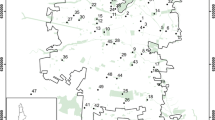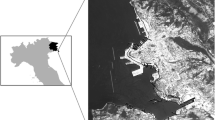Abstract
Urbanized areas show a high proportion of non-native plants and can work as dispersal points to the surrounding areas. Ensenada is a fast growing city located in the northwestern peninsula of Baja California (Mexico). It is the southern extreme of a bi-national, coastal urban corridor that extends from Los Angeles, California south to Ensenada. This corridor is part of the biodiversity hotspot of the California Floristic Province. The aim of this study was to analyze the composition and distribution of the spontaneous flora in the city of Ensenada. We systematically sampled two differentiated urban environments, vacant lots and arroyos, in 2006 and 2007. We found a total of 158 plant species, 61% of them were non-native species. Arroyo areas showed higher non-native species richness than vacant lots (21.9 vs. 13.6 species/transect) and could be potential dispersal vectors for non-native species to natural areas outside of the city, or in the reverse direction also.




Similar content being viewed by others
References
Bertin RI (2002) Losses of native plant species from Worcester, Massachusetts. Rhodora 104:325–349
Blair RB (2001) Birds and butterflies along urban gradients in two ecoregions of the U.S. In: Lockwood JL, McKinney ML (eds) Biotic homogenization. Kluwer, Norwell, MA, pp 33–56
Bossard CC, Randall JM, Hoshovsky MC (2000) Invasive plants of California’s wildlands. University of California Press, Los Angeles, CA
Cal-IPC (2006) California invasive plant inventory. Cal-IPC Publication 2006-02. California Invasive Plant Council, Berkeley, CA Available at: http://www.cal-ipc.org. Accesed 22 June 2008
Cal-IPC (2007) Inventory update. California Invasive Plant Council, Berkeley, CA Available at: http://www.cal-ipc.org. Accesed 22 June 2008
Celesti Grapow L, Blasi C (1998) A comparison of the urban flora of different phytoclimatic regions in Italy. Glob Ecol Biogeogr Lett 7:367–378. doi:10.2307/2997684
U.S. Census Bureau (2001) Census TIGER data base [map]. Washington, DC. Available at http://arcdata.esri.com/data/tiger2000/ Accessed 24 April 2008
CNA (2008) Normales climatológicas 1971–2000. Estación Agua Caliente, Ensenada, B.C. Available at: http://www.smn.cna.gob.mx Accesed 14 May 2008
Czech B, Krausman PR, Devers PK (2000) Economic associations among causes of species endangerment in the United States. Bioscience 50:593–601. doi:10.1641/0006-3568(2000)050[0593:EAACOS]2.0.CO;2
Dallman P (1998) Plant life in the world’s Mediterranean climates. University of California Press, Berkeley, CA
Dana ED, Vivas S, Mota JF (2002) Urban vegetation of Almería City—a contribution to urban ecology in Spain. Landsc Urban Plan 59:203–216. doi:10.1016/S0169-2046(02)00039-7
Dark SJ (2004) The biogeography of invasive alien plants in California: an application of GIS and spatial regression analysis. Divers Distrib 10:1–9. doi:10.1111/j.1472-4642.2004.00054.x
Espejel I, Aramburo G, Leyva C, Cruz Y, Bravo LC, Zuñiga W (2002) Coastal vegetation of Northwest Baja California: conservation options. Bight Bulletin / Boletín de la Cuenca 5:1–5
Fox MD, Fox BJ (1986) The susceptibility of natural communities to invasion. In: Groves RH, Burdon JJ (eds) Ecology of biological invasions: an Australian perspective. Australian Academy of Science, Canberra, pp 57–66
Franceschi EA (1996) The ruderal vegetation of Rosario City, Argentina. Landsc Urban Plan 34:11–18. doi:10.1016/0169-2046(95)00203-0
Gilbert OL (1989) The ecology of urban habitats. Chapman & Hall, London, UK
Gobierno de Baja California (2002) Impacto del sector turismo en la economía de Baja California. Secretaría de Turismo del Estado, Gobierno de Baja California, Mexicali, BC
Godefroid S (2001) Temporal analysis of the Brussels flora as indicator for changing environmental quality. Landsc Urban Plan 52:203–224. doi:10.1016/S0169-2046(00) 00117-1
Gutte P (1978) Zur Kenntnis einiger peruanischer Ruderalpflanzengesellschaften und ihr Vergleich mit europaischen Einheiten. Acta Bot. Slov. Acad. Sci. Slov., A, Taxon. Geobot 3:253–264
Hobbs RJ (1989) Effects of disturbance relative to invasions. In: Drake JA, Mooney HA, Di Castri F, Groves RH, Kruger FJ, Rejmánek M, Williamson M (eds) Biological invasions: a global perspective. Wiley and Sons, Chichester, UK, pp 389–405
INEGI (1998) Curvas de nivel de Baja California y Baja California Sur, Escala 1: 250, 000. INEGI, Aguascalientes
INEGI (2005) Conjunto de Datos Vectoriales de la Carta de Uso del Suelo y Vegetación, Escala 1:250, 000, Serie III. INEGI, Aguascalientes
INEGI (2006) Censo de población y vivienda 2005. Available at: www.inegi.gob.mx Accesed 14 March 2008
Kendle T, Forbes S (1997) Urban nature conservation. Chapman and Hall, London, UK
Kowarik I (1995) On the role of alien species in urban flora and vegetation. In: Pyšek P, Prach KK, Rejmánek M, Wade M (eds) Plant invasions—general aspects and special problems. SPB Academic, Amsterdam, pp 85–103
Kunick W (1982) Comparison of the flora of some cities of the central European lowlands. In: Bornkamm R, Lee JA, Seeward MRD (eds) Urban ecology. 2nd European Ecological Symposium. Blackwell Scientific, Oxford, pp 13–22
La Sorte FA, McKinney ML (2006) Compositional similarity and the distribution of geographical range size for assemblages of native and non-native species in urban floras. Divers Distrib 12:679–686. doi:10.1111/j.1472-4642.2006.00276.x
Lake JC, Leishman MR (2004) Invasion success of exotic in natural ecosystems: the role of disturbance, plant attributes and freedom from herbivores. Biol Conserv 117:215–226. doi:10.1016/S0006-3207(03)00294-5
Lambin EF, Turner BL, Geist HJ, Agbola SB, Angelsen A, Bruce JW, Coomes OT, Dirzo R, Fischer G, Folke C, George PS, Homewood K, Imbernon J, Leemans R, Li X, Moran EF, Mortimore M, Ramakrishnan PS, Richards JF, Skanes H, Steffen W, Stone GD, Svedin U, Veldkamp TA, Vogel C, Xu J (2001) The causes of land-use and land-cover change: moving beyond the myths. Glob Environ Change 11:261–269. doi:10.1016/S0959-3780(01)00007-3
Maskell LC, Bullock JM, Smart SM, Thompson K, Hulme PE (2006) The distribution and habitat associations of non-native plant species in urban riparian habitats. J Veg Sci 17:499–508. doi:10.1658/1100-9233(2006)17[499:TDAHAO]2.0.CO;2
McGranahan G, Satterthwaite D (2003) Urban centers: an assessment of sustainability. Annu Rev Environ Resour 28:243–274. doi:10.1146/annurev.energy.28.050302.105541
McKinney ML (2002) Urbanization, biodiversity and conservation. Bioscience 52:883–890. doi:10.1641/0006-3568(2002)052[0883:UBAC]2.0.CO;2
McKinney ML (2006) Urbanization as a major cause of biotic homogenization. Biol Conserv 127:247–260. doi:10.1016/j.biocon.2005.09.005
McKinney ML (2008) Effects of urbanization on species richness: a review of plants and animals. Urban Ecosyst 11:161–176. doi:10.1007/s11252-007-0045-4
McKinney ML, Lockwood JL (1999) Biotic homogenization: a few winners replacing many losers in the next mass extinction. Trends Ecol Evol 14:450–453. doi:10.1016/S0169-5347(99)01679-1
McKnight NN (1993) Biological pollution: the control and impact of invasive exotic species. Indiana Academy of Science, Indianapolis
Minnich RA, Franco-Vizcaíno E (1998) Land of Chamise and Pines: historical accounts and current status of northern Baja California’s vegetation. University of California Press, Berkely and Los Angeles, CA
Montenegro G, Teillier S, Arce P, Poblete V (1991) Introduction of plants into the Mediterranean-type climate area of Chile. In: Groves RH, Di Castri F (eds) Biogeography of Mediterranean invasions. Cambridge University Press, Cambridge, pp 103–114
Mulroy TW, Rundel PW, Bowler PA (1979) The vascular flora of Punta Banda, Baja California Norte, México. Madrono 26:69–90
Murphy HT, VanDerWal J, Lovett-Doust L, Lovett-Doust J (2006) Invasiveness in exotic plants: immigration in an ecological continuum. In: Cadotte MW, McMahon SM, Fukami T (eds) Conceptual ecology and invasion biology: reciprocal approaches to nature. Springer, Dordrecht, The Netherlands, pp 65–105
Myers N, Mittermeier RA, Mittermeier CG, da Fonseca GAB, Kents J (2000) Biodiversity hotspots for conservation priorities. Nature 403:853–858. doi:10.1038/35002501
Ojeda-Revah L, Bocco G, Ezcurra E, Espejel I (2008) Land-cover/use transitions in the binational Tijuana river watershed during a period of rapid industrialization. Appl Veg Sci 11:107–116
O’Leary JF (1995) Coastal sage scrub: threats and current status. Fremontia 23:27–31
Pauchard A, Aguayo M, Peña E, Urrutia R (2006) Multiple effects of urbanization on the biodiversity of developing countries: The case of a fast-growing metropolitan area (Concepcion, Chile). Biol Conserv 127:272–281. doi:10.1016/j.biocon.2005.05.015
Piñera-Ramírez D (2006) Los orígenes de las poblaciones de Baja California. Factores externos, nacionales y locales. Universidad Autónoma de Baja California, Mexicali, BC
Pyšek P (1993) Factors affecting the diversity of flora and vegetation in central European settlements. Vegetatio 106:89–100. doi:10.1007/BF00044860
Pyšek P (1998a) Alien and native species in Central European urban floras: a quantitative comparison. J Biogeogr 25:155–163. doi:10.1046/j.1365-2699.1998.251177.x
Pyšek P (1998b) Is there a taxonomic pattern to plant invasions? Oikos 82:282–294. doi:10.2307/3546968
Rapoport E, Díaz-Betancourt ME, López-Moreno IR (1983) Aspectos de la ecología urbana en la Ciudad de México: Flora de las calles y baldíos. Limusa, México DF
Rebman JP, Simpson MG (2006) Checklist of the vascular plants of San Diego County. San Diego Natural History Museum—San Diego State University, San Diego, CA
Rejmánek M (1989) Invasibility of plant communities. In: Drake JA, Mooney HA, di Castri F, Groves RH, Kruger FJ, Rejmánek M, Williamson M (eds) Biological invasions. Wiley & Sons, New York, pp 369–388
Rejmánek M, Randall JM (1994) Invasive alien plants in California: 1993 summary and comparison with other areas in North America. Madrono 41:161–177
Schierenbeck KA, Ellstrand NC, Blosser G (2007) Spatiotemporal patterns in the non-native flora of California, USA. Madrono 54:105–116. doi:10.3120/0024-9637(2007)54[105:SPITNF]2.0.CO;2
Sharpe DM, Stearns F, Leitner LA, Dorney JR (1986) Fate of natural vegetation during urban development of rural landscapes in Southeastern Wisconsin. Urban Ecol 9:267–287. doi:10.1016/0304-4009(86)90004-5
Stohlgren T, Bull K, Otsuki Y, Villa C, Lee M (1998) Riparian zones as havens for exotic plant species in the central grasslands. Plant Ecol 138:113–125. doi:10.1023/A:1009764909413
Vibrans H (1998) Urban weeds of Mexico City. Floristic composition and important families. Inst Biol Univ Nac Auton Mex Bot 69:37–69
Villaseñor JL, Espinosa-García FJ (2004) The alien flowering plants of Mexico. Divers Distrib 10:113–123. doi:10.1111/j.1366-9516.2004.00059.x
Vincent G, Bergeron Y (1985) Weed synecology and dynamics in urban environment. Urban Ecol 9:161–175. doi:10.1016/0304-4009(85)90004-X
Whitney GG (1985) A quantitative analysis of the flora and plant communities of a representative midwestern U.S. town. Urban Ecol 9:143–160. doi:10.1016/0304-4009(85)90003-8
Acknowledgements
We are grateful to Daniel Vázquez for his help in the field work and to Charlotte E. González-Abraham for her assistance with maps. The financial support that made possible this work was provided by Instituto Nacional de Ecología, México (INE).
Author information
Authors and Affiliations
Corresponding author
Rights and permissions
About this article
Cite this article
Garcillán, P.P., Rebman, J.P. & Casillas, F. Analysis of the non-native flora of Ensenada, a fast growing city in northwestern Baja California. Urban Ecosyst 12, 449–463 (2009). https://doi.org/10.1007/s11252-009-0091-1
Published:
Issue Date:
DOI: https://doi.org/10.1007/s11252-009-0091-1




